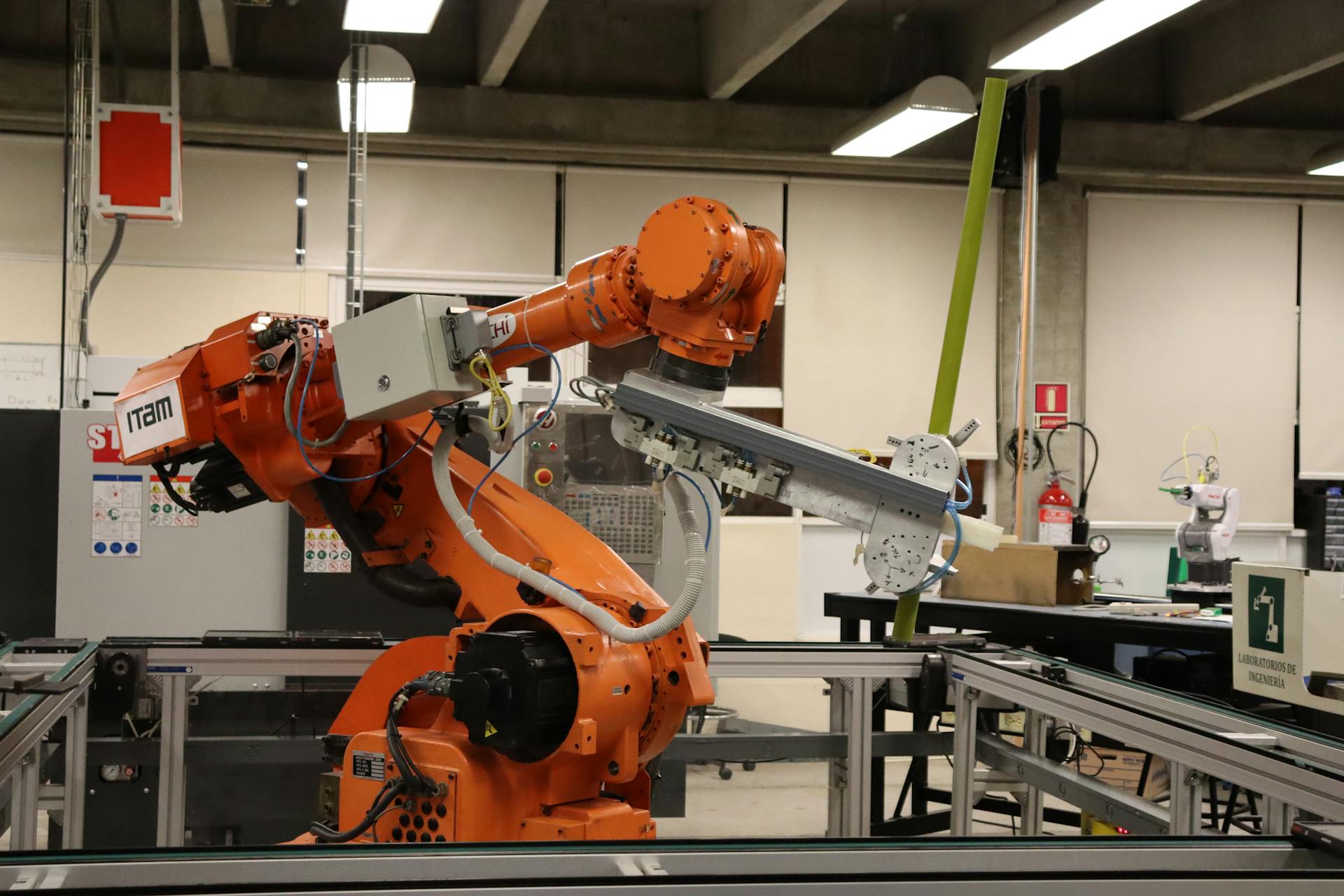
Human in the loop machine learning is a collaborative approach that combines the strengths of humans and machines. This method acknowledges that AI systems are not perfect and can benefit from human oversight and correction.
By involving humans in the loop, machine learning models can improve their accuracy and reliability. For instance, a study found that human evaluation can increase the accuracy of text classification models by up to 20%.
In this approach, humans and machines work together to develop and refine AI systems. This collaboration can lead to more efficient and effective AI development, as humans can provide context and nuance that machines may miss.
Human in the loop machine learning is particularly useful in applications where accuracy and reliability are critical, such as medical diagnosis or financial forecasting.
Benefits and Applications
Human-in-the-loop machine learning offers numerous benefits, including improved accuracy and adaptability. By incorporating human intervention, organizations can ensure the appropriate training of ML models.
In some cases, fully automated systems can be inflexible and frustrating to use, but human-in-the-loop systems can provide better flexibility and user experience. This is because humans can quickly identify and label patterns that may be challenging for machines to detect, reducing the amount of time and resources needed for model training.
One of the key benefits of human-in-the-loop systems is better efficiency. By catching errors early on, organizations can save time and resources in the long run by avoiding costly mistakes or inaccurate results.
A unique perspective: Human in a Loop
AI Types
There are three main types of "Human in the Loop AI" that researchers are exploring.
These approaches aim to improve machine learning, accuracy, speed, effectiveness, and efficiency of humans involved in the process.
One type is Human-in-the-loop machine learning (HITL-ML), which focuses on collaboration between humans and machine learning algorithms.
Researchers are exploring fresh ways to make this collaboration more effective and efficient.
The goal of HITL-ML is to improve the accuracy or speed of machine learning, as well as the effectiveness and efficiency of humans involved.
Applications and Use Cases
Human-in-the-Loop (HITL) machine learning has numerous applications and use cases where accuracy, adaptability, and personalized service are crucial.
In customer service, HITL can analyze customer data and provide relevant recommendations to human representatives, leading to more accurate and personalized service.
HITL can also be used in benefit determination, where it can analyze data from benefit applications and flag potential issues or discrepancies for human review.
One of the most significant benefits of HITL is its ability to improve the quality of models through human review. When humans review errors made by the models, they can assess where training data can be augmented, understand if the model is biased towards certain attributes, and how data guidelines could be modified to reduce annotation ambiguity or data bias.
Here are some of the most common HITL applications and use cases:
- Benefit Determination
- Customer Service
- Model Improvement Through Human Review
These applications and use cases demonstrate how HITL can be more effective than attended automation in situations where accuracy, adaptability, and personalized service are important.
Design and Approach
Designing a human-in-the-loop machine learning system requires a thoughtful approach that incorporates human factors and interaction. This approach reframes an automation problem as a Human-Computer Interaction (HCI) design problem, allowing for the selective inclusion of human participation.
The general blueprint for such a system involves harnessing the efficiency of intelligent automation while remaining amenable to human feedback. This process retains a greater sense of meaning and purpose, making it a more effective and engaging way to work with machines.
Machine teaching and interactive machine learning are two approaches that empower human domain experts to control the learning process. Machine teaching allows experts to define and constrain the knowledge they intend to impart to the machine learning model, while interactive machine learning involves cooperation between users and learning systems, enabling computers to learn from humans by chatting with them in everyday language.
For your interest: Learning with Errors
Teaching Approach
Machine teaching is a methodology that empowers human domain experts with control over the learning process, allowing them to define and constrain the knowledge they intend to impart to the machine learning model.
This approach enables a more directed and intentional transfer of expertise, making it a valuable tool in the field of human-in-the-loop machine learning.
Active learning involves a system retaining control over the learning process and views humans as oracles responsible for annotating unlabeled data.
According to Forbes, active learning ensures a model gains valuable insights from every labeled data point it encounters.
Machine teaching and active learning are two approaches that can be used to create human-in-the-loop machine learning systems, each with its own strengths and applications.
Here are some key differences between the two approaches:
Ultimately, the choice of teaching approach will depend on the specific needs and goals of the project, as well as the expertise and preferences of the human domain experts involved.
Cost and Resources
Having humans involved in the process means additional costs and resources, such as hiring data annotators or having a team of experts continuously monitoring the system.
This can be a significant challenge for smaller companies or startups with limited budgets.
The cost of training and maintaining large language models is mostly only open to large organizations with huge funding and backing for their research and development.
Human Oversight and Ethics
Human oversight is crucial for building trust in AI systems. Transparency is key, and having humans in the loop allows for better explanations of how decisions are made.
Involving humans in the decision-making process ensures responsible control and accountability in deploying AI systems. This approach cultivates trust among various stakeholders, including the public.
By augmenting machine learning models with human input, particularly at the decision-making step, the reasoning behind the model's decisions can be more easily explained and understood. This is especially valuable in industries like healthcare and finance.
Human-in-the-loop systems address bias in machine learning models, a phenomenon that may manifest during the training phase or emerge after deployment. Involving humans in the process enables the timely identification and rectification of bias.
AI systems are only as good as the data they are fed, and unfortunately, data can be biased due to human error or historical inequalities. By incorporating Human-in-the-Loop, you can continuously monitor for bias and make corrections when necessary.
Worth a look: Pruning in Decision Tree
Human-in-the-loop provides transparency in machine learning decisions, ensuring a human understands and can justify the decisions. This is especially important in situations like loan applications, where applicants can seek explanations for rejections and receive guidance for improvement.
Human oversight and ethics go hand-in-hand, and by prioritizing transparency and fairness, we can create more trustworthy and responsible AI systems.
Explore further: Automated Decision-making
Challenges and Limitations
Human-in-the-loop machine learning comes with its own set of challenges. Ensuring the accuracy of training data is a major concern, as it needs to mirror the diversity found in real-world scenarios to enable generalization.
Repetitive tasks, such as data labeling, can cause exhaustion and burnout in users, ultimately affecting the quality and consistency of the annotations produced.
One of the biggest drawbacks of human-in-the-loop is that processes are slower compared to fully automated ones. This is because humans can't perform tasks as rapidly as machines.
Here are some of the key challenges of human-in-the-loop:
- Accuracy of Training Data
- Processes Are Slower
- Humans Get Tired
- Increased Human Error
- More Expensive
- Higher Likelihood of Bias
- Complex Data Labeling
Human error is another significant challenge, as humans can introduce biases and overlook edge cases during algorithm training. This is why it's crucial to have proper checks and balances in place and continuously monitor for human error.
Challenges of
One of the biggest challenges of Human-in-the-Loop (HITL) is accuracy of training data. Ensuring that the training data accurately mirrors the diversity found in real-world scenarios can be a challenge, influencing the generalization abilities of machine learning models.
Repetitive tasks, such as data labeling, can cause exhaustion and burnout in users, ultimately affecting the quality and consistency of the annotations produced.
Humans are prone to making mistakes, and in the context of HITL, this can lead to increased human error during algorithm training. This is where individuals may overlook edge cases or introduce biased decisions.
Another challenge of HITL is the increased likelihood of bias. Human-in-the-loop machine learning systems can unintentionally introduce biases influenced by the viewpoints and interpretations of human annotators.
A systematic and efficient process is essential for incorporating human input and feedback into the system, especially when scaling up to complex AI systems.
Here are some of the key challenges of HITL:
- Accuracy of Training Data
- Processes Are Slower
- Humans Get Tired
- Increased Human Error
- More Expensive
- Higher Likelihood of Bias
- Complex Data Labeling
Risk Assessment
Risk Assessment can be a daunting task, but HITL ML can lend a helping hand. An ML system can analyze customer profiles and claim history to provide recommendations to a human underwriter.
This assistance can lead to more informed decisions about risk and coverage. In the insurance industry, for instance, ML can help underwriters assess the likelihood of a customer filing a claim.
By leveraging data and ML algorithms, underwriters can make more accurate predictions about risk. This, in turn, can help insurance companies offer more tailored coverage options to their customers.
Ultimately, HITL ML can help streamline the risk assessment process, freeing up underwriters to focus on more complex and high-value tasks.
Use Cases and Examples
Human-in-the-Loop (HITL) machine learning is being used in various industries to provide more accurate and personalized service. Chatbots are being used to provide basic customer support, but when a complex issue arises, a human agent can take over.
Customer service chatbots are becoming increasingly popular, with Gartner predicting they will continue to gain popularity over the next five years. They are used to provide basic customer support, but human agents can take over when complex issues arise or the chatbot cannot understand the query.
In the medical field, doctors review and validate the decisions made by AI models for chest radiograph diagnosis. This is just one example of how HITL is being used to improve accuracy and adaptability in medical diagnosis systems.
Autonomous vehicles, such as Tesla, use AI and sensors to navigate roads, but they still require human intervention in certain situations. This is another example of how HITL is being used to improve the reliability and safety of autonomous vehicles.
Some common examples of HITL systems include:
- Customer service chatbots
- Medical diagnosis systems
- Autonomous vehicles
Future and Next Steps
Human-in-the-Loop machine learning is poised to revolutionize business productivity and efficiency.
By combining the strengths of humans and machines, HITL ML can improve accuracy, adaptability, transparency, and user experience. This is especially true for organizations that deploy HITL ML in a way that leverages human supervision to ensure accountability and fairness in its outcomes.
Humans and machines each have their own strengths and limitations, which is why incorporating human oversight into AI systems is crucial for creating accurate, transparent, and ethical systems.
As AI advances and becomes more integrated into our daily lives, incorporating Human-in-the-Loop will become increasingly important for ensuring its safe and responsible use.
Incorporating HITL ML can lead to more accurate and transparent systems, which is why data professionals have a critical role in designing and monitoring AI systems.
Frequently Asked Questions
What is the loop method in machine learning?
Human-in-the-loop (HITL) is a machine learning process where humans provide input to improve AI accuracy and efficiency. This collaborative approach enables more precise results and streamlined applications.
What is the human-in-the-loop control theory?
Human-in-the-loop (HITL) refers to a control theory where a model or system requires human interaction and oversight to function effectively. This approach is used in various contexts, including modeling, simulation, and the development of autonomous weapons.
Sources
- https://hai.stanford.edu/news/humans-loop-design-interactive-ai-systems
- https://sigma.ai/human-in-the-loop-machine-learning/
- https://www.hyperscience.com/blog/human-in-the-loop-machine-learning-vs-attended-automation-whats-the-difference/
- https://portfolink.com/blog/hitl-machine-learning/
- https://careerfoundry.com/en/blog/data-analytics/human-in-the-loop/
Featured Images: pexels.com


